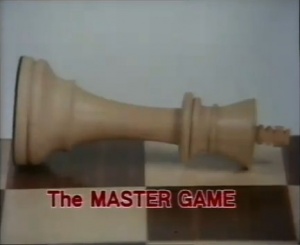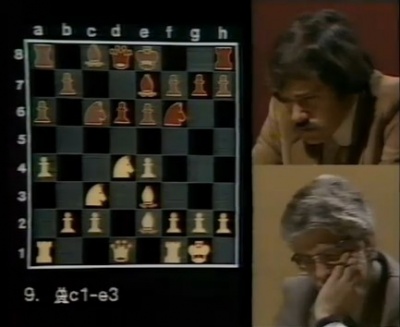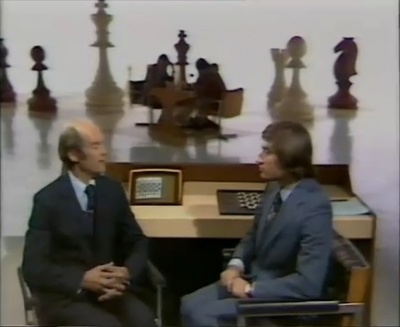The Master Game
Contents |
Host
Co-hosts
Analyser:
Leonard Barden (1975-78)
William Hartston (1979-82)
Broadcast
BBC2, 25 June 1975 to 28 April 1982 (75 episodes in 7 series; see Trivia)
Synopsis
Chess competition featuring many of the world's best players competing for the Wedgewood Trophy and prize money - rising from £250 to £2500 as both money and the quality of competition inflated.
To make the show, a knockout chess tournament was played, with a generous time limit of about two hours per player. The basic idea was to film good chess and show the best bits, rather than show poor chess made to fit the slot.
As soon as each game had finished, the players went to the studio, and recounted their thoughts during the game. On a later date, they sat at a special board, set up as though they were playing in the studio.
The Master Game is also remembered for its clear graphics. The real chess pieces had symbols stuck to their base. By a combination of mirrors and video editing, and a chessboard display that lit up squares, the player and analyst could demonstrate their thinking.
Thirty years on, the show is still fondly recalled as perhaps the most successful attempt at televising chess (as also suggested by the fact that it ran for nearly a decade - in prime time, as well), thanks especially to its innovation of having the players provide their own commentary which was recorded after the game and edited in.
Champions
| 1975 | William Hartston |
| 1977 | William Hartston |
| 1978 | Anatoly Karpov |
| 1979 | Bent Larsen |
| 1980 | Lothar Schmid |
| 1981 | Nigel Short |
| 1982 | Eric Lobron |
| 1983 | Tony Miles |
Inventor
Robert Toner devised the television coverage and tournament structure. He did not invent the game of chess.
Trivia
A series was recorded in 1982, intended for broadcast in 1983. Industrial action at the BBC meant the show never aired in the UK. We believe this series was dubbed and later broadcast in Germany.
The moves for each show were published on Ceefax page 259, starting a chess column that continued on the teletext service until 2010.
Moves were also published in next week's edition of The Listener magazine.
Merchandise
Two tie-in books were published.
The 1981 and 1982 series have been released on DVD, and a box set combines both tournaments.




